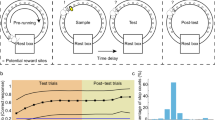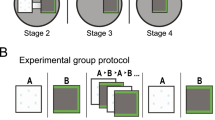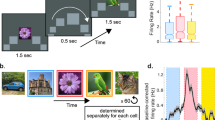Abstract
The ability to recall discrete memories is thought to depend on the formation of attractor states in recurrent neural networks1,2,3,4. In such networks, representations can be reactivated reliably from subsets of the cues that were present when the memory was encoded, at the same time as interference from competing representations is minimized. Theoretical studies have pointed to the recurrent CA3 system of the hippocampus as a possible attractor network3,4. Consistent with predictions from these studies, experiments have shown that place representations in CA3 and downstream CA1 tolerate small changes in the configuration of the environment but switch to uncorrelated representations when dissimilarities become larger5,6,7,8,9. However, the kinetics supporting such network transitions, at the subsecond timescale, is poorly understood. Here we show in rats that instantaneous transformation of the spatial context does not change the hippocampal representation all at once but is followed by temporary bistability in the discharge activity of CA3 ensembles. Rather than sliding through a continuum of intermediate activity states, the CA3 network undergoes a short period of competitive flickering between preformed representations of the past and present environment before settling on the latter. Network flickers are extremely fast, often with complete replacement of the active ensemble from one theta cycle to the next. Within individual cycles, segregation is stronger towards the end, when firing starts to decline, pointing to the theta cycle as a temporal unit for expression of attractor states in the hippocampus. Repetition of pattern-completion processes across successive theta cycles may facilitate error correction and enhance discriminative power in the presence of weak and ambiguous input cues.
This is a preview of subscription content, access via your institution
Access options
Subscribe to this journal
Receive 51 print issues and online access
$199.00 per year
only $3.90 per issue
Buy this article
- Purchase on Springer Link
- Instant access to full article PDF
Prices may be subject to local taxes which are calculated during checkout



Similar content being viewed by others
References
Hopfield, J. J. Neural networks and physical systems with emergent collective computational abilities. Proc. Natl Acad. Sci. USA 79, 2554–2558 (1982)
Amit, D. J., Gutfreund, H. & Sompolinsky, H. Storing infinite numbers of patterns in a spin-glass model of neural networks. Phys. Rev. Lett. 55, 1530–1533 (1985)
McNaughton, B. L. & Morris, R. G. M. Hippocampal synaptic enhancement and information storage within a distributed memory system. Trends Neurosci. 10, 408–415 (1987)
Treves, A. & Rolls, E. T. Computational constraints suggest the need for two distinct input systems to the hippocampal CA3 network. Hippocampus 2, 189–199 (1992)
Muller, R. U. & Kubie, J. L. The effects of changes in the environment on the spatial firing of hippocampal complex-spike cells. J. Neurosci. 7, 1951–1968 (1987)
Lee, I., Yoganarasimha, D., Rao, G. & Knierim, J. J. Comparison of population coherence of place cells in hippocampal subfields CA1 and CA3. Nature 430, 456–459 (2004)
Leutgeb, J. K. et al. Progressive transformation of hippocampal neuronal representations in ‘morphed’ environments. Neuron 48, 345–358 (2005)
Wills, T. J., Lever, C., Cacucci, F., Burgess, N. & O’Keefe, J. Attractor dynamics in the hippocampal representation of the local environment. Science 308, 873–876 (2005)
Colgin, L. L. et al. Attractor-map versus autoassociation based attractor dynamics in the hippocampal network. J. Neurophysiol. 104, 35–50 (2010)
O’Keefe, J. & Nadel, L. The Hippocampus as a Cognitive Map (Oxford Univ. Press, 1978)
Gothard, K. M., Skaggs, W. E., Moore, K. M. & McNaughton, B. L. Binding of hippocampal CA1 neural activity to multiple reference frames in a landmark-based navigation task. J. Neurosci. 16, 823–835 (1996)
Samsonovich, A. & McNaughton, B. L. Path integration and cognitive mapping in a continuous attractor neural network model. J. Neurosci. 17, 5900–5920 (1997)
Derdikman, D. et al. Fragmentation of grid cell maps in a multicompartment environment. Nature Neurosci. 12, 1325–1332 (2009)
O’Keefe, J. & Speakman, A. Single unit activity in the rat during a spatial memory task. Exp. Brain Res. 68, 1–27 (1987)
Gothard, K. M., Skaggs, W. E. & McNaughton, B. L. Dynamics of mismatch correction in the hippocampal ensemble code for space: interaction between path integration and environmental cues. J. Neurosci. 16, 8027–8040 (1996)
Skaggs, W. E. & McNaughton, B. L. Spatial firing properties of hippocampal CA1 populations in an environment containing two visually identical regions. J. Neurosci. 18, 8455–8466 (1988)
Leutgeb, S., Leutgeb, J. K., Treves, A., Moser, M.-B. & Moser, E. I. Distinct ensemble codes in hippocampal areas CA3 and CA1. Science 305, 1295–1298 (2004)
Tsodyks, M. & Sejnowski, T. Associative memory and hippocampal place cells. Int. J. Neural Syst. 6, 81–86 (1995)
Romani, S. & Tsodyks, M. Continuous attractors with morphed/correlated maps. PLoS Comput. Biol. 6, e1000869 (2010)
McNaughton, B. L., Battaglia, F. P., Jensen, O., Moser, E. I. & Moser, M. B. Path integration and the neural basis of the ‘cognitive map’. Nature Rev. Neurosci. 7, 663–678 (2006)
Johnson, A. & Redish, A. D. Neural ensembles in CA3 transiently encode paths forward of the animal at a decision point. J. Neurosci. 27, 12176–12189 (2007)
Fenton, A. A. & Muller, R. U. Place cell discharge is extremely variable during individual passes of the rat through the firing field. Proc. Natl Acad. Sci. USA 95, 3182–3187 (1998)
Olypher, A. V., Lánský, P. & Fenton, A. A. Properties of the extra-positional signal in hippocampal place cell discharge derived from the overdispersion in location-specific firing. Neuroscience 111, 553–566 (2002)
Jackson, J. & Redish, A. D. Network dynamics of hippocampal cell-assemblies resemble multiple spatial maps within single tasks. Hippocampus 17, 1209–1229 (2007)
Kelemen, E. & Fenton, A. A. Dynamic grouping of hippocampal neural activity during cognitive control of two spatial frames. PLoS Biol. 8, e1000403 (2010)
Blumenfeld, B., Preminger, S., Sagi, D. & Tsodyks, M. Dynamics of memory representations in networks with novelty-facilitated synaptic plasticity. Neuron 52, 383–394 (2006)
Tsodyks, M. V., Skaggs, W. E., Sejnowski, T. J. & McNaughton, B. L. Population dynamics and theta rhythm phase precession of hippocampal place cell firing: a spiking neuron model. Hippocampus 6, 271–280 (1996)
Akrami, A., Liu, Y., Treves, A. & Jagadeesh, B. Converging neuronal activity in inferior temporal cortex during the classification of morphed stimuli. Cereb. Cortex 19, 760–776 (2009)
Harris, K. D., Csicsvari, J., Hirase, H., Dragoi, G. & Buzsáki, G. Organization of cell assemblies in the hippocampus. Nature 424, 552–556 (2003)
Colgin, L. L. et al. Frequency of gamma oscillations routes flow of information in the hippocampus. Nature 462, 353–357 (2009)
Acknowledgements
We thank R. Skjerpeng, A. M. Amundsgård, K. Haugen, K. Jenssen, E. Kråkvik and H. Waade for technical assistance. The work was supported by the 7th Framework Programme of the European Commission (‘SPACEBRAIN’, grant agreement no. 200873), an Advanced Investigator Grant to M.-B.M. from the European Research Council (‘ENSEMBLE’), the Kavli Foundation, a Centre of Excellence grant from the Norwegian Research Council, and research projects MSMT CR LC554, 1M0517 and AV0Z50110509 at the Academy of Sciences of the Czech Republic.
Author information
Authors and Affiliations
Contributions
K.J., A.T., M.-B.M. and E.I.M. designed the study and discussed analyses and results; K.J. built the apparatus, K.J. and E.J.H. performed experiments, K.J. performed analyses; E.I.M. wrote the paper with input from all authors.
Corresponding authors
Ethics declarations
Competing interests
The authors declare no competing financial interests.
Supplementary information
Supplementary Information
This file contains Supplementary Materials and Methods, Supplementary Figures 1-15 with legends and Supplementary Table 1. (PDF 21901 kb)
Rights and permissions
About this article
Cite this article
Jezek, K., Henriksen, E., Treves, A. et al. Theta-paced flickering between place-cell maps in the hippocampus. Nature 478, 246–249 (2011). https://doi.org/10.1038/nature10439
Received:
Accepted:
Published:
Issue Date:
DOI: https://doi.org/10.1038/nature10439
This article is cited by
-
Subfield-specific interneuron circuits govern the hippocampal response to novelty in male mice
Nature Communications (2024)
-
The medial septum controls hippocampal supra-theta oscillations
Nature Communications (2023)
-
Value dynamics affect choice preparation during decision-making
Nature Neuroscience (2023)
-
Organization and Priming of Long-term Memory Representations with Two-phase Plasticity
Cognitive Computation (2023)
-
Functional neuronal circuitry and oscillatory dynamics in human brain organoids
Nature Communications (2022)
Comments
By submitting a comment you agree to abide by our Terms and Community Guidelines. If you find something abusive or that does not comply with our terms or guidelines please flag it as inappropriate.



